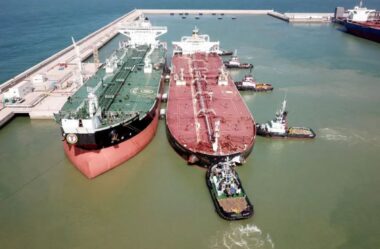Tempo de leitura: 8 minutos
Introduction to Foreign Trade Zones
In today’s global economy, businesses are constantly seeking ways to optimize their supply chain operations and reduce costs. One powerful tool that has gained significant attention in the logistics industry is the Foreign Trade Zone (FTZ). As international trade continues to grow, understanding the concept and benefits of FTZs has become crucial for companies looking to enhance their competitiveness in the global market.
In this comprehensive guide, we’ll delve into the world of Foreign Trade Zones, exploring what they are, how they work, and the numerous advantages they offer to businesses engaged in international trade. We’ll also discuss how digital logistics solutions like FreightAmigo can help companies leverage FTZs to streamline their operations and maximize their benefits.
What is a Foreign Trade Zone?
A Foreign Trade Zone, commonly referred to as an FTZ, is a secure area under the supervision of U.S. Customs and Border Protection (CBP). These designated zones are considered to be outside of U.S. customs territory for tariff purposes, despite being physically located within the United States. FTZs are designed to provide businesses with better trading opportunities in the global economy by offering a range of benefits related to customs duties, taxes, and regulatory requirements.
Key characteristics of Foreign Trade Zones include:
- Secure areas under CBP supervision
- Treatment of goods as if they were outside U.S. commerce
- Minimal administrative procedures
- Reduced or eliminated custom duties
- Enhanced efficiency in cross-border trade
Currently, there are approximately 293 active FTZs in the United States, with over 3,300 companies taking advantage of the Foreign Trade Zone program. These zones are strategically located near ports of entry, international airports, and major industrial areas to facilitate the movement of goods and support various business activities.
Foreign Trade Zones vs. Free Trade Zones
While the terms “Foreign Trade Zone” and “Free Trade Zone” are often used interchangeably, there are some key differences between the two concepts:
Foreign Trade Zones (FTZs)
- Located within the United States
- Operate under U.S. jurisdiction
- Supervised by U.S. Customs and Border Protection
- Focus on import/export activities and manufacturing
Free Trade Zones
- Located outside the United States
- Often found near international airports, seaports, or national boundaries
- Operate under the jurisdiction of the host country
- May have broader scope of activities beyond import/export
Both types of zones offer similar benefits in terms of customs duties and taxes, but their specific regulations and operations may vary depending on their location and governing authorities.
How Do Foreign Trade Zones Work?
Understanding the operations of Foreign Trade Zones is crucial for businesses looking to maximize their benefits. FTZs offer a wide range of activities that can be performed on merchandise without being subject to customs duties or certain regulatory requirements. These activities include:
- Storage
- Exhibition
- Assembly
- Manufacturing
- Testing
- Repackaging
- Relabeling
- Cleaning
- Mixing
- Salvage
- Sampling
- Repair
- Display
- Processing
It’s important to note that while a wide range of activities are permitted in FTZs, there are some restrictions. For example, retail trade is generally not allowed within these zones. Additionally, any production activity must be authorized by the FTZ Board to ensure compliance with regulations and safety standards.
FTZs are subject to scrutiny from local, state, and federal agencies to ensure the safety of imported products for consumers and the general public. If merchandise does not comply with established requirements, the FTZ Board has the authority to exclude it from the zone.
Benefits of Using Foreign Trade Zones
Foreign Trade Zones offer numerous advantages to businesses engaged in international trade. These benefits can significantly impact a company’s bottom line and competitive position in the global market. Let’s explore some of the key advantages of utilizing FTZs:
1. Duty Deferral and Elimination
One of the primary benefits of FTZs is the ability to defer or eliminate customs duties. Since FTZs are considered outside of U.S. customs territory, merchandise entering these zones is not subject to immediate customs duties or taxes. This allows companies to:
- Postpone duty payments until goods leave the FTZ and enter U.S. commerce
- Avoid duties on goods that are re-exported from the FTZ
- Reduce overall duty payments by taking advantage of lower duty rates on finished products
For example, a company importing electronic components can store them in an FTZ, assemble them into finished products, and only pay duties on the finished goods when they enter the U.S. market. This can result in significant cost savings, especially for businesses dealing with high-value or high-volume imports.
2. Inverted Tariff Relief
Inverted tariffs occur when the duty rate on imported parts or components is higher than the duty rate on the finished product. This situation can put U.S. manufacturers at a disadvantage compared to foreign competitors. FTZs help address this issue by allowing companies to:
- Pay the lower finished product duty rate on imported components
- Improve competitiveness against foreign manufacturers
- Encourage domestic manufacturing and job creation
By utilizing FTZs, U.S. manufacturers can level the playing field and maintain their production facilities within the country, supporting local economies and preserving jobs.
3. Inventory Tax Relief
Also known as ad valorem tax relief, this benefit exempts inventory stored in FTZs from state and local inventory taxes. This advantage allows businesses to:
- Reduce carrying costs on inventory
- Improve cash flow by deferring tax payments
- Increase inventory flexibility and responsiveness to market demands
For businesses with large inventories or seasonal products, this tax relief can result in substantial savings and improved financial management.
4. Enhanced Quality Control and Compliance
FTZs provide an opportunity for companies to inspect and process goods before they officially enter U.S. commerce. This allows businesses to:
- Identify and address quality issues before paying duties
- Repackage, repair, or destroy non-conforming items within the zone
- Ensure compliance with U.S. regulations and standards
By catching and resolving issues early, companies can avoid costly returns, improve customer satisfaction, and maintain compliance with regulatory requirements.
5. Streamlined Customs Procedures
FTZs offer simplified and expedited customs procedures, which can lead to:
- Reduced paperwork and administrative costs
- Faster processing times for imports and exports
- Improved supply chain efficiency and responsiveness
These streamlined procedures can be particularly beneficial for companies dealing with time-sensitive products or those operating in industries with rapidly changing market demands.
6. Enhanced Global Competitiveness
By leveraging the benefits of FTZs, businesses can:
- Reduce overall operating costs
- Improve cash flow management
- Increase flexibility in their supply chain operations
- Compete more effectively in global markets
These advantages can be particularly significant for small and medium-sized enterprises looking to expand their international presence and compete with larger, established players in the global market.
Implementing FTZ Strategies with Digital Logistics Solutions
While the benefits of Foreign Trade Zones are clear, implementing effective FTZ strategies can be complex and challenging for many businesses. This is where digital logistics solutions like FreightAmigo can play a crucial role in helping companies maximize the advantages of FTZs.
How FreightAmigo Supports FTZ Operations
As a full-service, one-stop Digital Logistics Platform, FreightAmigo offers a range of features and capabilities that can help businesses optimize their FTZ operations:
- Comprehensive Visibility: FreightAmigo’s platform provides real-time tracking and monitoring of shipments, allowing businesses to maintain full visibility of their inventory within FTZs and throughout the supply chain.
- Automated Documentation: The platform’s automated document generation capabilities can help streamline the paperwork associated with FTZ operations, reducing administrative burdens and ensuring compliance with customs regulations.
- Intelligent Rate Comparison: FreightAmigo’s rate comparison tools can help businesses identify the most cost-effective shipping options for moving goods in and out of FTZs, further optimizing their supply chain costs.
- Customs Clearance Support: The platform offers integrated customs clearance services, helping businesses navigate the complex regulatory landscape associated with FTZ operations.
- Data Analytics and Reporting: FreightAmigo’s advanced analytics capabilities can provide valuable insights into FTZ operations, helping businesses identify areas for improvement and make data-driven decisions.
- Integration with Existing Systems: The platform can integrate seamlessly with existing ERP and warehouse management systems, ensuring smooth information flow and operational efficiency.
By leveraging these digital tools and capabilities, businesses can more effectively implement and manage their FTZ strategies, maximizing the benefits while minimizing the complexities and risks associated with international trade.
Conclusion: Embracing FTZs for Supply Chain Optimization
Foreign Trade Zones represent a powerful tool for businesses looking to optimize their supply chain operations and enhance their competitiveness in the global market. By offering benefits such as duty deferral, tax relief, and streamlined customs procedures, FTZs can significantly impact a company’s bottom line and operational efficiency.
However, to fully leverage the advantages of FTZs, businesses need to navigate complex regulations, manage intricate logistics processes, and maintain strict compliance standards. This is where digital logistics solutions like FreightAmigo become invaluable partners in the journey towards supply chain optimization.
By combining the strategic benefits of Foreign Trade Zones with the technological capabilities of advanced Digital Logistics Platforms, businesses can create a powerful synergy that drives efficiency, reduces costs, and enhances their ability to compete on a global scale.
As the world of international trade continues to evolve, embracing these innovative solutions will be key to staying ahead in an increasingly competitive and complex global marketplace. Whether you’re a small business just starting to explore international markets or a large corporation looking to optimize your existing global supply chain, the combination of FTZ strategies and digital logistics solutions offers a path to enhanced efficiency, reduced costs, and improved competitiveness.
Fonte: Freight Amigo | Foto: Divulgação






Os comentários foram encerrados, mas trackbacks e pingbacks estão abertos.